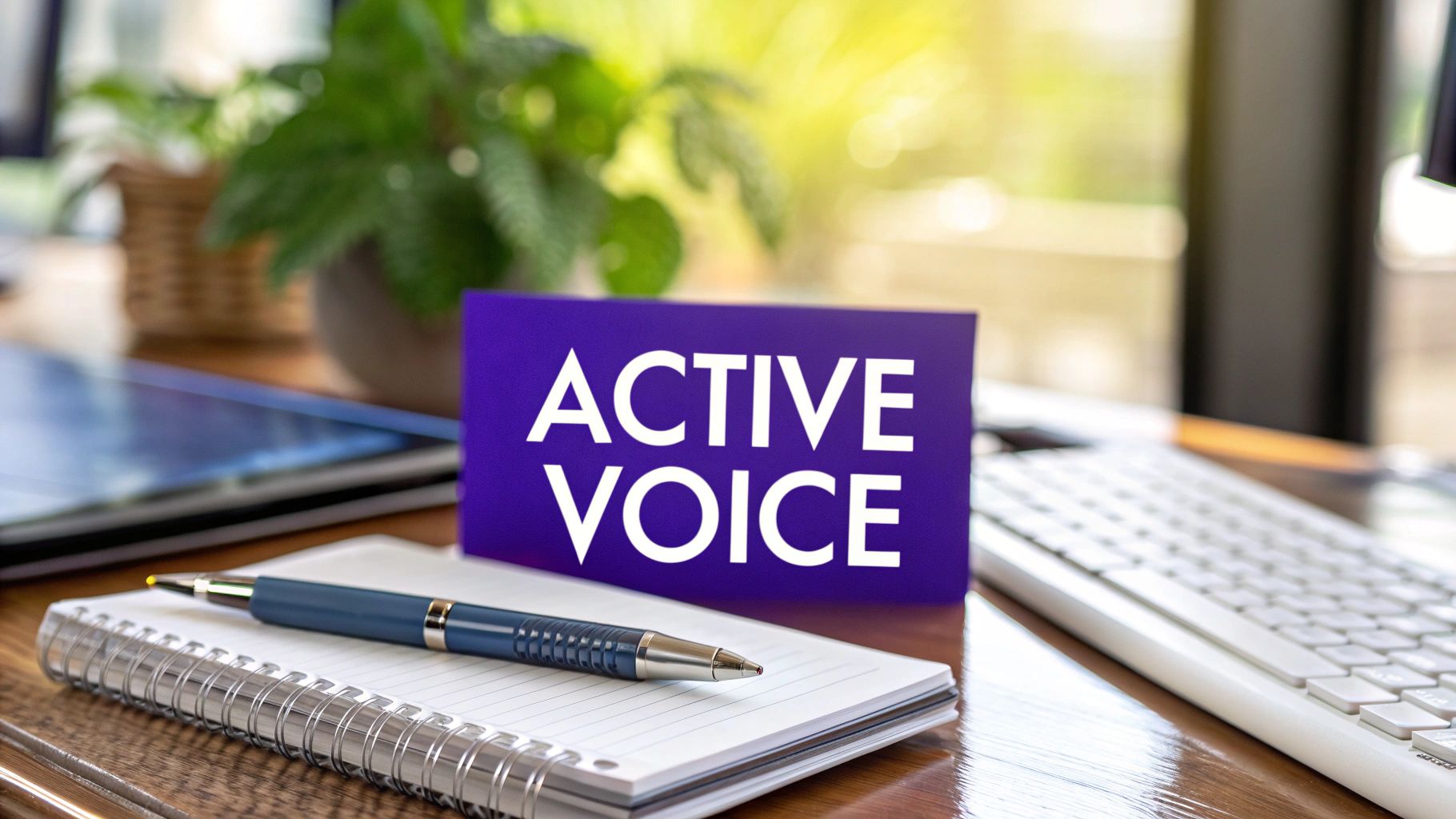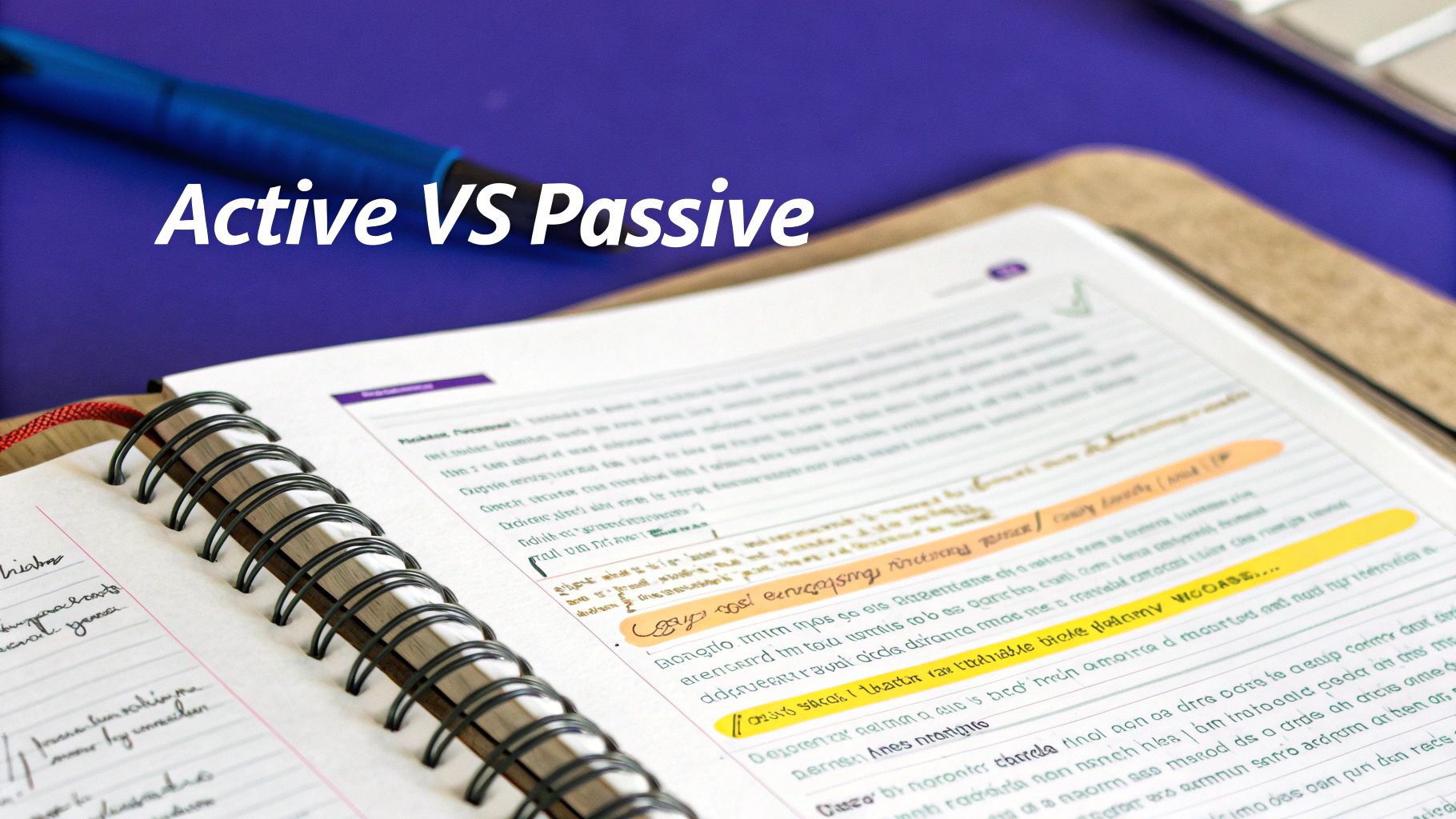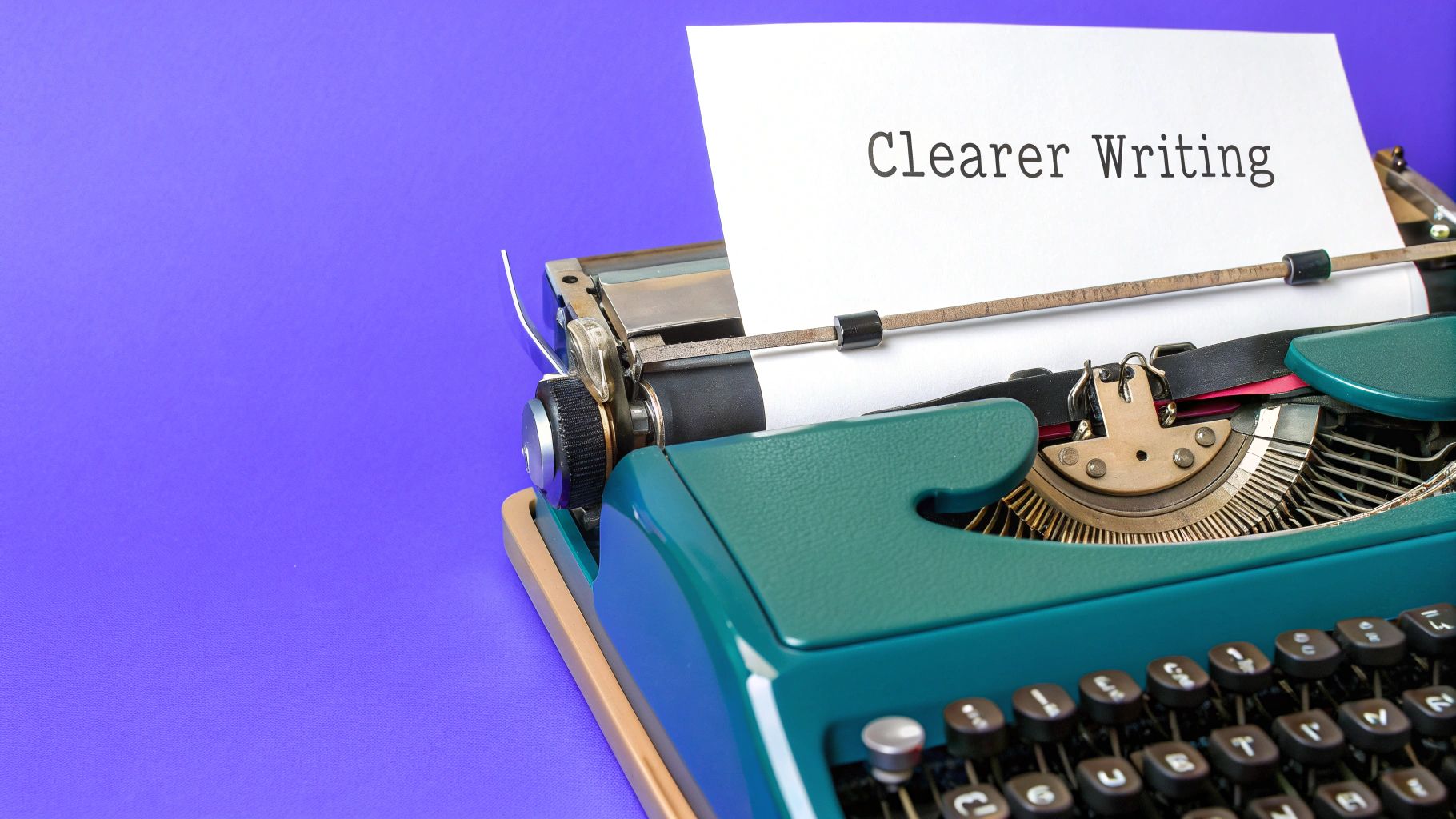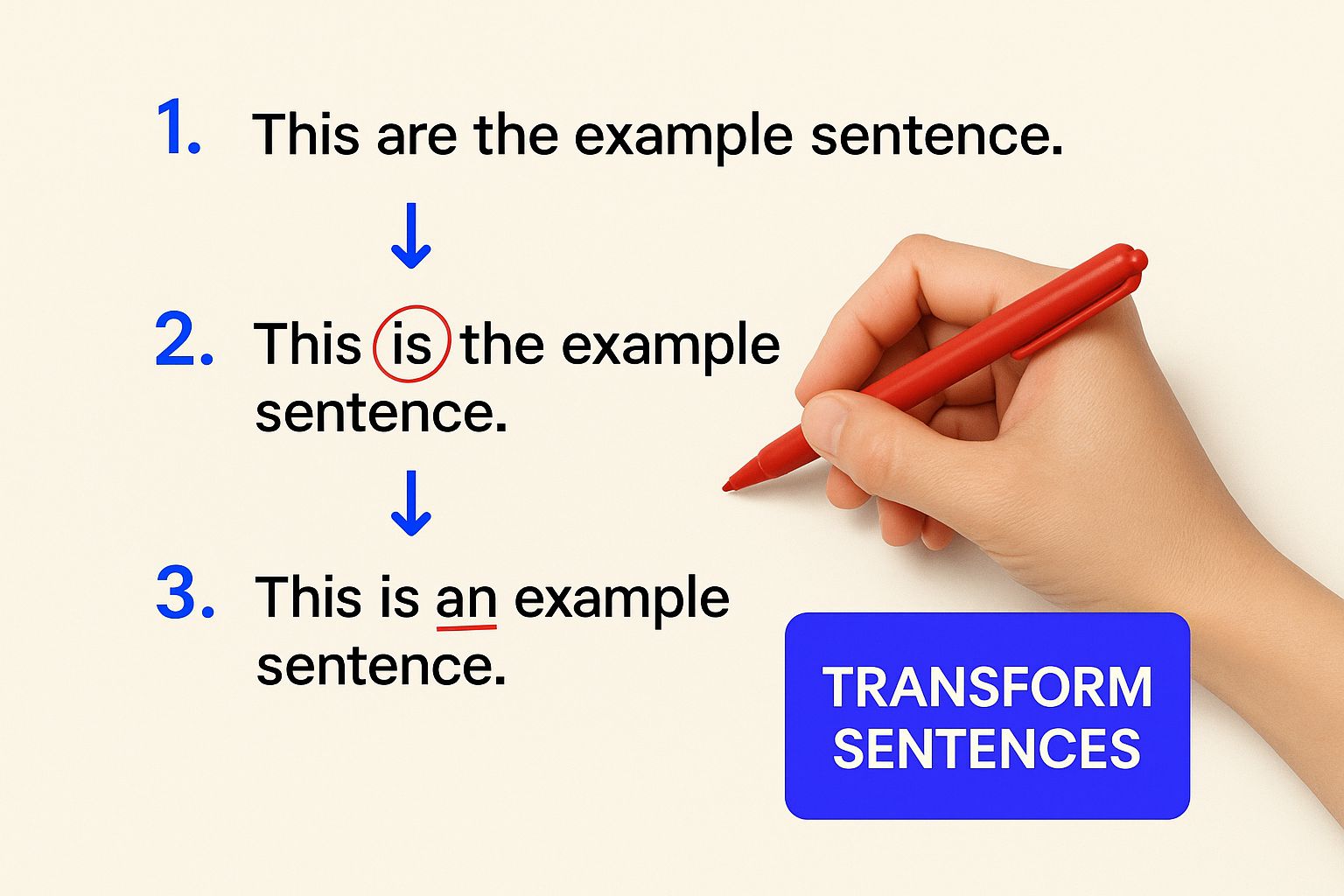How to Change from Passive to Active Voice Effectively
Unlock the power of active voice in your writing! This guide explores the critical differences between passive and active voice, offering practical techniques to transform your prose for improved clarity and reader engagement.

Decoding Passive vs. Active Voice: What Really Matters
 Let's explore the core distinctions between passive and active voice. Understanding these differences is crucial for transforming your writing and crafting compelling emails.
Let's explore the core distinctions between passive and active voice. Understanding these differences is crucial for transforming your writing and crafting compelling emails.
Tools like those available on Quiky can be helpful in this process, whether you're using the Email Writer or creating a Thank You Note. This exploration will equip you with the knowledge to identify and utilize the appropriate voice for maximum impact.
Identifying The Core Difference: Action and Agency
Active voice vibrates with energy. The subject of the sentence directly acts. The subject is in charge. For example, "The manager approved the proposal." Here, "manager" (the subject) directly performs the "approving" action. This directness fosters a clear, concise message.
In passive voice, however, the subject becomes the recipient of the action. The focus shifts from who acts to what receives it. Our previous example, rewritten in the passive voice, becomes "The proposal was approved by the manager." The subject ("proposal") receives the action, creating a more indirect tone.
This passive construction can be useful in certain contexts. Often, though, it can lead to less engaging prose.
Spotting Passive Voice: Telltale Signs
Passive voice often relies on forms of the verb "to be" (is, are, was, were) combined with a past participle. Look out for "by" phrases. These often indicate passive voice, though not always. "The email was sent" is passive, while "The email was sent yesterday" is not. Recognizing these patterns is key to shifting from passive to active voice.
Why This Distinction Matters: Engagement and Clarity
The shift from passive to active voice mirrors broader changes in how we communicate and consume information. Active participation has become increasingly prevalent. In 2020, for instance, 70% of US adults used social media, demonstrating a preference for active engagement. This parallels the need for active voice in writing, creating dynamic communication. You can explore this societal shift in more detail at PlankSip.
Maintaining consistent messaging across these platforms is crucial. Consider reviewing effective Social Media Cross-Posting Strategies to optimize your reach.
To illustrate the differences between these two voice constructions, let's look at a few examples.
The following table provides a direct comparison, highlighting why active voice is often the preferred choice.
Passive vs. Active Voice Comparison
Passive Voice Example | Active Voice Alternative | Why It's Better |
|---|---|---|
The email was written by the assistant. | The assistant wrote the email. | More concise and direct. |
The meeting was scheduled by the team. | The team scheduled the meeting. | Clearly identifies the actor. |
Results were analyzed by the researchers. | The researchers analyzed the results. | Emphasizes the researchers' role. |
By understanding these core differences, you can strategically choose between active and passive voice, optimizing your writing for clarity and impact, particularly when crafting communications with Quiky.
Why Making the Passive to Active Shift Transforms Your Writing
 Changing passive to active voice profoundly impacts how your writing resonates with readers. More than a simple grammatical rule, it's a shift in perspective that infuses your prose with energy and clarity. A passive sentence like "The email was sent," becomes more dynamic, "I sent the email." This seemingly small change makes a big difference.
Changing passive to active voice profoundly impacts how your writing resonates with readers. More than a simple grammatical rule, it's a shift in perspective that infuses your prose with energy and clarity. A passive sentence like "The email was sent," becomes more dynamic, "I sent the email." This seemingly small change makes a big difference.
The active voice immediately identifies the actor, eliminating ambiguity and creating a more direct connection with the reader. This directness is essential for strong, effective writing.
Active Voice Enhances Clarity and Engagement
Active voice reduces the mental effort required to process information. Readers instantly understand who performed the action, leading to increased engagement. This clarity also cultivates authority and trust. When you explicitly state responsibility, it demonstrates confidence and transparency, making your message more persuasive.
Active voice minimizes cognitive load, allowing readers to focus on the message rather than deciphering the sentence structure. This improved comprehension enhances their experience and encourages them to continue reading.
The Impact on SEO and Reader Trust
SEO best practices consistently emphasize the importance of active voice. Search engines prioritize clear, concise content, qualities directly supported by active voice construction. This clarity also strengthens the writer-reader relationship. By clearly stating responsibility, you build trust and credibility, fostering a stronger connection with your audience. To further understand the mechanics of active and passive voice, explore resources like this.
Active voice contributes to improved SEO rankings by enhancing readability and clarity. Search engines recognize and reward content that is easily understood by their users.
Active Participation Drives Results
The concept of active engagement extends beyond writing. Studies on consumer behavior have shown a surprising difference between Passive Innovation Resistance (PIR) and Active Innovation Resistance (AIR). While PIR, a more passive approach, decreases adoption of new products, AIR actually increases it. This can be further explored in research on customer behavior and innovation. This suggests that active participation, even in opposition, leads to greater engagement and understanding.
This principle underscores the power of taking ownership and communicating directly. By embracing active voice, you imbue your writing with a sense of directness and purpose, making your message more compelling and memorable.
5 Battle-Tested Techniques to Change From Passive to Active
 This infographic visualizes the process of transforming sentences from passive to active voice. It uses the analogy of a hand holding a red pen to make corrections, highlighting the step-by-step approach required to identify and rectify passive constructions. The key takeaway? Actively engaging with your writing is paramount for clear and concise communication. These techniques empower writers to make informed decisions, much like selecting the right tools on Quiky for crafting a feedback request email.
This infographic visualizes the process of transforming sentences from passive to active voice. It uses the analogy of a hand holding a red pen to make corrections, highlighting the step-by-step approach required to identify and rectify passive constructions. The key takeaway? Actively engaging with your writing is paramount for clear and concise communication. These techniques empower writers to make informed decisions, much like selecting the right tools on Quiky for crafting a feedback request email.
Just as you choose the perfect email tool, these techniques help you choose the perfect voice.
Identify the "To Be" Verbs
Recognizing the hallmarks of passive voice is the first step. Passive voice often uses a form of the verb "to be" (is, am, are, was, were, be, being, been) coupled with a past participle. For example, "The email was written by me" uses "was" and the past participle "written," clearly indicating passive voice. Identifying these verb combinations is crucial for the conversion process.
Locate the True Actor
After identifying a passive construction, find the true actor—the one performing the action. In "The email was written by me," the true actor is "me." Pinpointing the actor allows for sentence restructuring, placing them at the forefront.
Place the Actor Before the Verb
This step restructures the sentence to emphasize the actor. Moving "me" to the beginning transforms the sentence into "I wrote the email"—a more direct and concise statement. This simple shift strengthens the impact of the sentence.
Adjust the Verb Tense if Necessary
Sometimes, switching from passive to active requires verb tense adjustments. "The cake was eaten by the dog" becomes "The dog ate the cake." "Was eaten" (past tense passive) changes to "ate" (past tense active). This maintains grammatical accuracy and meaning.
Revise and Refine
Finally, refine the revised sentence. Replace weak verbs with stronger alternatives and remove unnecessary words. “The report was reviewed by the committee” could become “The committee scrutinized the report.” This enhances the impact of the active voice.
This process, like crafting the perfect subject line with Quiky's Subject Line Generator, can be iterative.
To further illustrate these techniques, let's examine a table outlining their application:
Active Voice Transformation Techniques
Technique | How to Apply It | Example Transformation |
|---|---|---|
Identify "To Be" Verbs | Look for forms of "to be" + past participle. | "The report was written by John." |
Locate the True Actor | Identify who performs the action. | John |
Place Actor Before the Verb | Restructure the sentence to place the actor first. | "John wrote the report." |
Adjust Verb Tense (If Necessary) | Ensure correct tense after restructuring. | "John wrote the report" (no change needed) |
Revise and Refine | Replace weak verbs, remove unnecessary words. | "John drafted the report." |
This table provides a clear, step-by-step guide for converting passive voice to active voice. By mastering these techniques, writers can ensure their prose is direct, concise, and impactful.
These five techniques offer a practical framework for transforming passive sentences into active ones. They empower writers to create concise, engaging content, ensuring their message resonates effectively.
When Passive Voice Actually Works: Strategic Exceptions
While most writing advice emphasizes switching from passive to active voice, strategic exceptions exist where the passive voice is more effective. Sometimes, highlighting the action's recipient takes precedence, or a delicate situation necessitates a less direct approach. Understanding these nuances empowers writers to make conscious, strategic choices about voice instead of rigidly following rules.
Emphasizing The Recipient: Shifting The Spotlight
Consider the headline "Groundbreaking Cancer Treatment Discovered." The emphasis here is on the treatment—a significant advancement benefiting countless people. Switching to active voice ("Scientists Discover Groundbreaking Cancer Treatment") shifts the focus, potentially diminishing the treatment's impact. Passive voice strategically highlights what was affected, not who did the affecting.
Navigating Sensitive Situations With Tact
In delicate circumstances, passive voice provides a crucial buffer. Imagine a company announcing job cuts. "The company laid off 50 employees" sounds blunt and insensitive. "Fifty employees were laid off" softens the message while conveying the necessary information. This subtle shift demonstrates empathy and consideration during difficult times.
Diplomacy and Obscuring Responsibility
Sometimes, strategically obscuring responsibility is the most diplomatic approach. In international relations or crisis management, passive constructions can de-escalate tense situations. "Mistakes were made," for instance, acknowledges shortcomings without assigning blame, fostering more constructive dialogue. This strategic ambiguity can prove essential in navigating complex political or corporate environments.
Scientific Writing: Objectivity and Methodology
Scientific writing often employs passive voice, especially when describing methodology. "The samples were analyzed" emphasizes the process and results, not the researcher's actions. Prioritizing objectivity, this approach aligns with scientific principles, focusing on the experiment itself, not the individuals involved.
Further illustrating this trend toward active consumer participation is the critical role of technological empowerment and regulatory support. The EU's General Data Protection Regulation (GDPR) empowers consumers to control their data. Platforms like Amazon, with over 300 million active users in 2023, highlight the impact of consumer reviews on product success. Learn more about this at TalentQuest.
Enhancing Sentence Flow and Readability
Occasionally, passive voice simply improves sentence flow. Converting every passive construction to active voice can result in choppy, awkward prose. "The data was collected, analyzed, and then presented to the board" is a good example. Changing this to active voice might create a less elegant sentence. Sometimes, retaining the passive voice contributes to a more natural, coherent flow.
By understanding these exceptions, writers gain more control over their communication. Recognizing when passive voice serves a purpose elevates writing beyond simply following grammar rules, empowering writers to make informed decisions based on context and desired impact.
Avoiding The Passive-To-Active Conversion Traps
Changing from passive voice to active voice is a powerful way to strengthen writing, but it's not always a simple swap. Even experienced writers can stumble into common traps that diminish the effectiveness of their active voice revisions. Let's examine these pitfalls and discuss how to avoid them, ensuring your transition to active voice truly elevates your writing.
The Emphasis Shift: Losing Your Intended Meaning
One common mistake is unintentionally shifting the emphasis of a sentence. For example, "The email was sent by the marketing team" becomes "The marketing team sent the email." While grammatically correct, this changes the focus from the email being sent to who sent it. If the key point is the act of sending, the passive voice may be more effective.
Awkward Constructions: When The Actor Is Unclear
Difficulty arises when the actor performing the action is unknown or unimportant. Changing "The decision was made" to "Someone made the decision" introduces an awkward vagueness. Rephrasing is often the best solution. "A decision was reached" or "The team concluded" are stronger alternatives.
Maintaining Formality: Active Voice Doesn't Mean Casual
Active voice isn't inherently informal. Many writers mistakenly equate the two, resorting to unnecessary passive constructions in formal writing. However, formality and active voice can coexist. "We submitted the report" is both formal and direct, unlike the passive "The report was submitted."
Tackling Complex Sentences: A Step-By-Step Approach
Converting every clause in a complex sentence to active voice can result in a choppy, disjointed flow. Instead, analyze the entire sentence's structure. Identify the main action and actor, then rebuild the sentence around that core, ensuring smooth transitions between clauses. For instance, "The data was collected, analyzed, and then the results were presented" becomes the more concise "We collected the data, analyzed it, and presented the results."
Preserving Meaning: The Ultimate Goal
The paramount concern is preserving the original meaning. Sometimes, the shift to active voice alters the nuance or focus, weakening the sentence's impact. Always compare the passive and active versions to ensure your core message remains intact. This careful comparison guarantees the change benefits your writing by adding clarity and strength without sacrificing meaning.
By understanding and avoiding these common pitfalls, you can effectively utilize the strength of active voice. This will empower you to write dynamic, engaging prose that delivers your message with precision and impact. Just as choosing the right tool on Quiky.email enhances email creation, mastering active voice elevates your writing skills.
Mastering Active Voice Across Different Writing Contexts
Active voice adapts to various writing styles, depending on the purpose. Whether composing academic research, business communications, marketing material, technical guides, or creative content, understanding active voice implementation is crucial.
Active Voice in Academic Writing
Academic writing often defaults to passive voice, prioritizing objectivity. However, active voice can enhance clarity and reader engagement without sacrificing scholarly rigor. For example, instead of "The experiment was conducted," consider "We conducted the experiment." This clearly identifies the actors, strengthening the sentence and improving readability.
Active Voice in Business Communications
Accountability is paramount in business. Active voice promotes this by explicitly stating who performs an action. "The report was submitted late" becomes "John submitted the report late." This clarifies responsibility, creating a more direct and transparent communication style.
Active Voice in Marketing and Technical Writing
Marketing relies on compelling calls to action. Active voice, with its subject-verb directness, amplifies these calls. "Our product can be used to improve efficiency" becomes the stronger "Improve your efficiency with our product." Technical documentation also benefits from active voice clarity, simplifying instructions. "The button should be pressed" becomes the more direct "Press the button." This concise phrasing ensures quick and accurate comprehension.
Active Voice in Creative Writing
Creative writing flourishes with active voice, breathing life into narratives. Active constructions empower writers to portray characters taking action, propelling the plot. Contrast "The door was opened by the wind" with "The wind slammed the door open." The active voice example is more vivid and impactful, creating engaging and memorable prose.
Navigating Contextual Challenges
Each writing style presents distinct challenges. Scientific writing traditionally favors passive voice. However, strategically using active voice can improve readability without compromising objectivity. Instructional content demands absolute clarity, making active voice essential. Even in formal writing, like legal documents, active voice can enhance clarity without sacrificing the required precision.
By tailoring your approach to each context, you can effectively leverage active voice, maximizing your writing's impact across genres and purposes. Adapting your voice to the specific audience and purpose is as important as crafting the message itself.
Key Takeaways
Essential learnings that you should remember from this article
- Active voice enhances clarity and engagement in writing.
- Identifying 'to be' verbs is crucial for recognizing passive voice.
- Strategic use of passive voice can be effective in certain contexts.
Practical Tips
Actionable tips you can apply immediately to improve your email performance
Identify Passive Constructions
Look for forms of 'to be' combined with past participles to spot passive voice.
Place the Actor First
Reconstruct sentences to place the subject performing the action at the forefront.
Revise for Strength
Replace weak verbs and remove unnecessary words to enhance the impact of your writing.
Common Mistakes to Avoid
Pitfalls and misconceptions to avoid when writing persuasive emails
- Shifting the emphasis of a sentence unintentionally when changing voice.
- Creating awkward constructions when the actor is unclear or unknown.
- Assuming active voice is always informal or casual.
Tools to Apply These Concepts
Put what you've learned into practice with these specialized tools
Related Content
Continue exploring with these related articles and tools